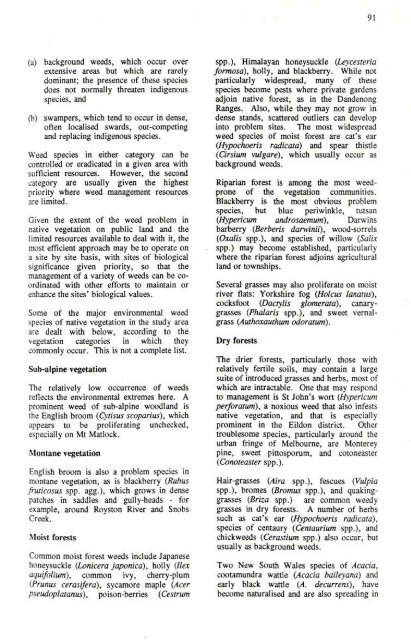Factors Affecting Flora Conservation - Victorian Environmental ...
Factors Affecting Flora Conservation - Victorian Environmental ...
Factors Affecting Flora Conservation - Victorian Environmental ...
You also want an ePaper? Increase the reach of your titles
YUMPU automatically turns print PDFs into web optimized ePapers that Google loves.
91<br />
(a) background weeds, which occur over<br />
extensive areas but which are rarely<br />
dominant; the presence of these species<br />
does not normally threaten indigenous<br />
species, and<br />
(b) swampers, which tend to occur in dense,<br />
often localised swards, out-competing<br />
and replacing indigenous species.<br />
Weed species in either category can be<br />
controlled or eradicated in a given area with<br />
suftlcient resources. However, the second<br />
category are usually given the highest<br />
priority where weed management resources<br />
are limited.<br />
Given the extent of the weed problem in<br />
native vegetation on public land and the<br />
limited resources available to deal with it, the<br />
most efficient approach may be to operate on<br />
a site by site basis, with sites of biological<br />
significance given priority, so that the<br />
management of a variety of weeds can be coordinated<br />
with other efforts to maintain or<br />
enhance the sites' biological values.<br />
Some of the major environmental weed<br />
species of native vegetation in the study area<br />
are dealt with below, according to the<br />
vegetation categories in which they<br />
commonly occur. This is not a complete list.<br />
Sub-alpine vegetation<br />
The relatively low occurrence of weeds<br />
refiects the environmental extremes here. A<br />
prominent weed of sub-alpine woodland is<br />
the English broom (Cytisus scoparius), which<br />
appears to be proliferating unchecked,<br />
especially on Mt Maflock.<br />
Montane vegetation<br />
English broom is also a problem species in<br />
montane vegetation, as is blackberry (Rubus<br />
fruticosus spp. agg.), which grows in dense<br />
patches in saddles and gully-heads - for<br />
example, around Royston River and Snobs<br />
Creek.<br />
Moist forests<br />
Common moist forest weeds include Japanese<br />
honeysuckle (Lonicera japonica), holly (Ilex<br />
aquifolium), common ivy, cherty-plum<br />
(Prunus cerasifera), sycamore maple (Acer<br />
pseudoplatanus), poison-berries (CJestrwn<br />
spp.), Himalayan honeysuckle (Leycesteria<br />
formosa), holly, and blackberry. While not<br />
particularly widespread, many of these<br />
species become pests where private gardens<br />
adjoin native forest, as in the Dandenong<br />
Ranges. Also, while they may not grow in<br />
dense stands, scattered oufliers can develop<br />
into problem sites. The most widespread<br />
weed species of moist forest are cat's ear<br />
(Hypochoeris radicata) and spear thistle<br />
(Cirsium vulgare), which usually occur as<br />
background weeds.<br />
Riparian foresi is among the most weedprone<br />
of the vegetation communities.<br />
Blackberry is the most obvious problem<br />
species, but blue periwinkle, tutsan<br />
(Hypericum androsaemum), Darwins<br />
barberry (Berberis darwinii), wood-sorrels<br />
{Oxalis spp.), and species of willow (Salix<br />
spp.) may become established, particularly<br />
where the riparian forest adjoins agricultural<br />
land or townships.<br />
Several grasses may also proliferate on moist<br />
river flats: Yorkshire fog (Holcus lanatus),<br />
cocksfoot (Dactylis glomerata), canarygrasses<br />
(Phalaris spp.), and sweet vernalgrass<br />
(Authoxauthwn odoratum).<br />
Dry forests<br />
The drier forests, particularly those with<br />
relatively fertile soils, may contain a large<br />
suite of introduced grasses and herbs, most of<br />
which are intractable. One that may respond<br />
to management is St John's wort (Hypericum<br />
perforatum), a noxious weed that also infests<br />
native vegetation, and that is especially<br />
prominent in the EUdon district. Other<br />
troublesome species, particularly around the<br />
urban fringe of Melboume, are Monterey<br />
pine, sweet pittospomm, and cotoneaster<br />
(Conoteaster spp.).<br />
Hair-grasses (Aira spp.), fescues (Vulpia<br />
spp.), bromes (Bromus spp.), and quakinggrasses<br />
(Briza spp.) are common weedy<br />
grasses in dry forests. A number of herbs<br />
such as cat's ear (Hypochoeris radicata),<br />
species of centaury (Centaurium spp.), and<br />
chickweeds (Cerastium spp.) also occur, but<br />
usually as background weeils.<br />
Two New South Wales species of Acacia,<br />
cootamundra wattle (Acacia baileyana) and<br />
early black wattle (A. decurrens), have<br />
become naturalised and are also spreading in
















